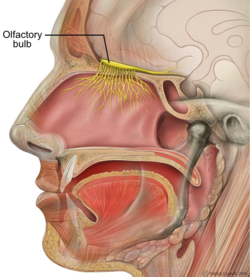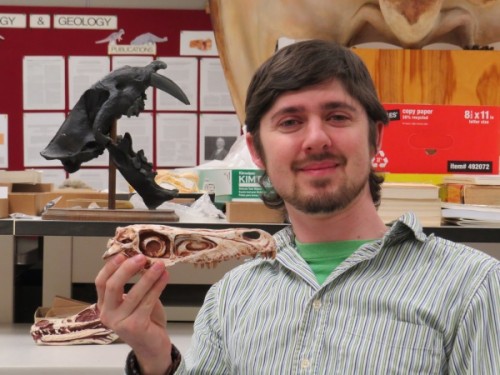
When you discover a new dinosaur species, you get to name it. Steven Jasinski at University of Pennsylvania has now named what his analysis of a fossilized dinosaur skull suggests is a brand new species. He’s calling it Saurornitholestes sullivani. This new dinosaur is thought to be related to Velociraptor, the fleet-footed dinosaur villain of the Jurassic Park franchise. Like the creatures portrayed in the movies, the newly named species likely was agile and fast. Plus it had something else: a keen sense of smell. Jasinski says it would have been a fierce predator. He reported his findings this month (May, 2015) in the New Mexico Museum of Natural History and Science Bulletin.
Jasinski is a doctoral student in Earth and Environmental Science at University of Pennsylvania and acting curator of paleontology and geology at the State Museum of Pennsylvania. He found the new species while investigating a 75-million-year-old fossil specimen. Paleontologist Robert Sullivan had originally found the specimen in the Bisti/De-Na-Zin Wilderness Area of New Mexico in 1999. When first described, scientists believed it was a member of Saurornitholestes langstoni, part of the Dromaeosauridae family – small to medium-sized bird-like dinosaurs that lived in present-day Alberta, Canada.

Jasinski did a comparative analysis of the New Mexico creature’s skull to other known S. langstoni specimens. That’s when he began to notice subtle differences. In particular, the skull corresponding with the brain’s olfactory bulb was unusually large.
This finding implies a powerful sense of smell. Jasinski said:
This feature means that Saurornitholestes sullivani had a relatively better sense of smell than other dromaeosaurid dinosaurs …
This keen olfaction may have made S. sullivani an intimidating predator as well.
S. sullivani lived near the end of the dinosaurs’ time on Earth, in the Late Cretaceous period. The newly identified species represents the only named dromaeosaur from this period in North America south of Montana.
At the time S. sullivani lived, North America was split into two continents separated by an inland sea. This dinosaur lived on the western shores in an area called Laramidia.
The new dinosaur species is thought to be a relatively small one. This specimen is estimated to be less than 3 feet (one meter) at its hip and roughly 6 feet in length. It likely hunted in fast-moving packs and used its acute sense of smell to track down prey.
Jasinski said:
Although it was not large, this was not a dinosaur you would want to mess with.
Via University of Pennsylvania

Bottom line: Steven Jasinski compared the skull of a fossilized dinosaur to the skulls of other similar creatures. He found the skull area corresponding to the creature’s sense of smell to be unusually large. He has now published his study declaring the specimen as an example of a brand new species of dinosaur, which he has named Saurornitholestes sullivani.











